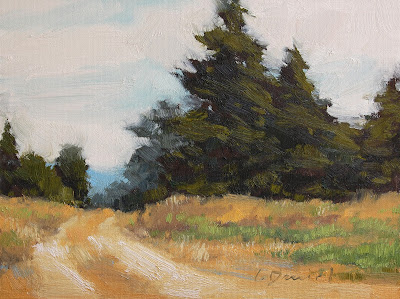Stolen Moment (enlarged), L. Daniel, 16 x 12
On Thursday evening I went to Fredericksburg, Texas to do a painting demo for the Die Kunstler Von Fredericksburg group. Since I was painting inside, at night, I chose to do an enlargement of a 6 x 8 plein air piece. The original was done the week before my daughter's wedding in June and it brings back many happy memories of that joyous time.
But beyond that, I also thought it would be a good scene to work through while explaining my painting process. More than 50 people came to the demo and they were a great crowd! Many thanks to the organizers and all who were there. I promised to post the whole thing here for a little review, so here we go...
A Demo of "Stolen Moment":
Line and Mass Block-in
Using French Ultramarine and Alizarin Crimson I lightly sketched in my composition.
Stepping back, I checked the drawing, made needed corrections and laid in the darkest darks.
For blocking-in, it's important to use a very dry brush and a light touch to avoid muddy colors later.
From here on, I will load the brush, continue to use a light touch and try not to scrub (more mud).
Foreground - Darks and Lights in Upright Plane
Using color to describe the darks and lights, I massed the shapes & kept them simple.
Later on I will break up the masses with subtle value and temperature shifts in each range.
(Upright plane refers to vertical elements, such as trees and foliage. It usually contains the darkest darks.)
Foreground - Darks and Lights in Ground Plane
Again, I focused on the simple shapes of the darks and lights - this time in the ground plane.
(The ground plane reflects the sky, so it's overall value is usually much lighter than the upright plane.)
I pushed the color a bit here, knowing that I will come back in with highlights at the end.
I tried to establish an overall vibrancy in the foreground that would contrast well with the muted distant shore.
Background - Establish overall Value
I try to compare every element; and here I compared "like" to "like"...
How are the elements in the background different from the same elements in the foreground?
Atmospheric conditions make the background cooler, more muted, softer, lighter...
I painted the background mass using the average best value and color to establish a sense of distance.
Background - Darks and Lights in Upright Plane.
Once the value was correct, I broke up the large background mass with subtle shifts of light and dark.
The value range is tighter (less contrasty) in the distance, so I avoided dark darks and intense color.
I kept detail at a minimum (it's far away and I know I can't see that detail!) :)
Middle-ground - Reflections in Ground Plane
Here again, I indicated reflections by using large masses that I will break up later.
(You should be seeing a trend... Large masses that get subdivided.)
Sky - Value and Nuance of Sky Plane
I generally paint the sky last, but I know lots of people who start there.
No matter when it's painted, the sky is an important key to the rest of the values in a painting.
The sky is usually the lightest area in a landscape because the sun is there...
once everything else established, I know how light I need to go.
Final Touches - Highlights and Sparkle
Painting is a practice in patience and delayed gratification.
I try really hard to establish the values and temperatures of all the masses before ever doing a single highlight.
Once the masses are working together, I begin to break them up and try not to overdo it.
Last, and I mean at the very end, I add the highlights and sparkle and any little details.
Honestly, when I follow my own advice on this, I am happiest with the outcome.

























